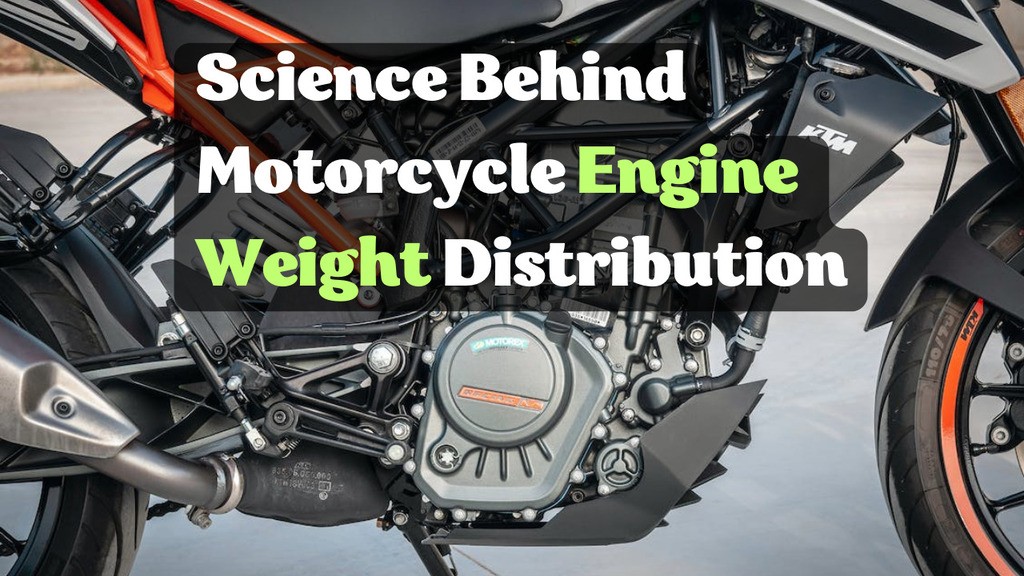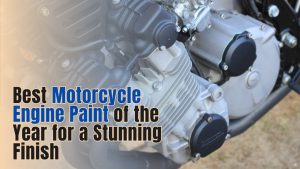Ever wonder why some bikes feel snappier than others off the line? Or how cruisers can rumble down the highway all day long without missing a beat? It all comes down to what’s under the hood – or rather, under the seat.
Motorcycle engine weight plays a key role in how your steed performs. Lighter engines allow bikes to change direction in a flash, while heavier duty powerplants deliver the torque to travel the open road.
We’ll take a look under the skin at what determines an engine’s poundage and explore real-world effects of engine weight on handling and ride quality.
Relationship Between Motorcycle Engine Weight and Size
Anyone who’s thrown a leg over more than one bike knows there’s a noticeable difference between a tiny 250cc and a heavy-hitting 1800cc muscle machine. But just how much does displacement impact motorcycle engine weigh?
Let’s break it down by some common engine capacities. Your average quarter-liter bike engine weighs in around 40-60 pounds depending on make. Not too shabby for buzzing around town. But bump up to a 600cc sportsbike and you’ve added 10-30 more pounds to hustle down backroads.
Things start getting seriously hefty when you enter big twin territory. A900cc cruiser powerplant can tip the scales at 130-170 pounds. That’s some serious bike engine weight enabling loads of low-end torque straight off the line.
Yet even those pound pretty light compared to racing breeds packing 1200cc+. A liter bike engine easily clears 200 pounds, sometimes stretching past 220.
Real-world riders know the impact all those extra cubes have in how their steed handles. More displacement demands sturdier construction to contain explosions inside each combustion chamber. That bulk shifts a bike’s center of gravity for better or worse depending on your style of twisting the throttle.
So before you purchase, consider how engine capacity and motorcycle engine weight chart lines up with your intended rides.
SEE MORE: What Is CC In Bike Engine and How it Impacts Ride’s Performance?
Impact of Engine Configuration on Motorcycle Engine Weight
Here are some different engine configurations:
Single Cylinder Simplicity
For many new riders, a single cylinder engine provides a lightweight way to learn. These simple motors often tip the scales around 40-50 pounds soaking wet.
Parallelogram Powerhouses
Whether in a V-twin or flat configuration, two-cylinder engines couple grunt with modest motorcycle engine weight.
These parallel twins impress with their svelte 60-80 pound silhouettes while churning out all the torque you’d ever need for canyon carving.
Multicylinder Muscle
Once you get into triple, quad, and five-cylinder engines pumping 120+ cubic inches, motorcycle engine weight grows considerably.
That bulk translates to stronger low-end acceleration ideal for racetracks or touring two-up with cargo for days. Inline configurations concentrate mass, so choose wisely based on intended duty and handling preference.
Between different strokes, cylinder arrangements affect heft, smoothness and maneuverability. So study configurations to find the ideal combination of oomph and agility for your style of riding.
Impacts of Engine Configuration
Engine configuration determines how much motorcycle engine weight nature you’re willing to bear. Inline fours demand serious heft to contain their elite power in a narrow package. Meanwhile, a single’s swagger comes from its feathery figure.
Beginners cut their teeth on singles due to forgiving weight distribution. But experienced riders say inlines excel in feel, with pistons counter-punching each pulse.
Peak horsepower means nothing if uneven power delivery leaves you rattled. V-twins tame vibrations, so cruisers glide in comfort. Yet two cylinders lose some in-line smoothness, so sports riders lean parallel.
Some swear by singles’ vibration therapy stimulating blood flow. But countless miles bonding with balanced engines prove their composure over bumpy roads.
Cylinder Number and Bike Engine Weight
Extra pistons pumping underground require solid construction to withstand their powerful pulses. This gives multicylinder engines an automatic motorcycle engine weight disadvantage compared to twins or singles. Still, builders offset mass with lightweight compounds whenever possible.
Two-stroke engines rev harder, thanks to their simplistic one-piston-stroke design. This innate RPM capability slashes bike engine weight to pair with nimble bikes.
However, less robust 4-stroke engines gain heft from extra parts that endow stronger low-end grunt better suited for daily riders and passengers.
Experts debate power-to-weight pros and cons. But riders just want their engine’s personality to match their style. Let personal preference determine whether your ideal companion will be a wispy two-stroke or a burly four-stroke bruiser.
SEE MORE: The Best Motorcycle Engine Paint of the Year for a Stunning Finish
Power Production and Its Impact on Motorcycle Engine Weight
Bragging rights come at a price when you crave gargantuan horsepower. Massive pistons, heavier-duty internals and reinforced casings pile on the pounds no matter the configuration. Tuners accept extra mass to access untapped performance realms.
Precision vs. Poundage
Lighter high-strung racers stake success on razor-sharp handling. So engineers shave grams wherever possible from tiny yet torquey mills.
Meanwhile, cruisers carry casual riders in comfort, prioritizing low-end grunt over raw peak horsepower. Not all heavyweight bikes have heavyweight engines.
Understanding the Balance
Riders know true speed transcends numbers. Skilled pilots coax max velocity from minimal machines through proficient control of momentum. Weight-conscious tuners still hit ludicrous power targets, relying on ergonomics instead of brute force.
In the end, motorcycle engine weight matters less than how smoothly you can apply its power down your favorite backroad.
Matching Motorcycle Size to Engine Weight
When you strap on 500 extra pounds of steel, that heft must be hauled by a stronger powerplant. Full-dress tourers pair 900cc engines weighing 150+ pounds for solid reliability traversing America. Forget towing!
Nimble dual-sports and standards thrive on 40-80 pound parallel twins. Their feathery weight invites experimenting on gnarly trails.
Rocket-light 250cc single-cylinder engines fuel new riders’ confidence as they develop skills. When ounces count, so does engine choice.
Manufacturers design engines and frames in harmony. While lighter bikes prioritize agility, adventure bikes demand dependable displacement to brave rugged terrain.
Choose an combination matching your mission while keeping limits in check. After all, it’s no fun if you can’t finish the ride!
How Different Materials Impact the Engine Weight
Gone are the days of all-iron dinosaur engines. Modern alloys like aluminum castings shed serious pounds versus heavier grey iron. Some even blend metals to an even lighter strength-to-weight ratio.
Carbon Cutting: Composite materials like carbon fiber join the mix. These man-made marvels allow intricate designs unthinkable in the past. Engineers precisely place just enough fibers to best resist specific forces. The result? Featherlight engine casings perfectly optimized.
Titanium’s Tight Reign: Exotic yet affordable, titanium remains king for dropping motorcycle engine weight while handling compression. It’s no wonder this magical metal gets added wherever possible on highest-strung mill options.
SEE MORE: How to Paint a Motorcycle Engine: A Detailed Step-by-Step Guide
Motorcycle Engine Weight Chart
This chart provides general guidelines on how motorcycle engine weight typically scales with displacement increases and different engine designs. Real world weights may differ due to continual engineering improvements.
| Displacement | Engine Type | Approx. Weight (lbs) |
|---|---|---|
| 400cc | Single cylinder | 45 |
| 650cc | Parallel twin | 70 |
| 750cc | Parallel twin | 80 |
| 850cc | V-twin | 110 |
| 900cc | V-twin | 130 |
| 1000cc | Inline 4 | 180 |
| 1100cc | V-twin | 150 |
| 1200cc | Flat twin | 160 |
| 1300cc | V-twin | 170 |
| 1400cc | V-twin | 190 |
| 1800cc | V-twin | 220 |
NOTES:
- Weights provided are estimates and can vary by manufacturer and model year
- Sportbikes and racing engines tend to be on the lighter side for displacement
- Cruiser and touring engines often on higher side of weight range for strength/durability
- Multi-cylinder and high performance engines use costly lightweight materials to reduce weight
- Engine configuration, components and intended use all factor into the overall weight
Are Heavy Motorcycle Engines Always Better?
Heavier isn’t always better when it comes to motorcycle engine weight. While burlier components enable towing travel trailers or tackling Baja, there’s a time and place for everything.
A success on the track demands wielding every ounce saved. Racers strip grams mercilessly to maximize cornering agility versus outright horsepower alone.
Cruisers prioritize smooth, low-end muscle over razor-sharp handling. Bigger V-twin power lets riders relax while devouring miles in luxurious touring asphalt.
Lightweight single-cylinder dirt bikes flourish where nimble flickability means surviving gnarly whoops and ruts. Dependability takes backseat to agility in the woods.
Ultimately, matching engine heft and construction quality appropriately to your intended mission yields the longest smiles per miles. So understand your preferences before committing to any engine’s permanent weight distribution.
FAQs About Motorcycle Engine Weight
How much does a typical motorcycle engine weigh?
Motorcycle engine weights can vary widely depending on size, configuration and materials used. As a general guide, small single-cylinder engines may weigh 40-60 lbs, twin-cylinder engines 60-120 lbs, large V-twin cruiser engines 130-180 lbs, and high-performance sportsbike engines 180 lbs and up.
What are some factors that affect engine weight?
Key factors include engine size/displacement, number of cylinders, configuration (V-twin, inline, etc.), materials used, complexity of components, intended power output and duty of the motorcycle. Larger engines, more cylinders, and higher power outputs generally require heavier construction.
Is heavier always worse for handling?
Not necessarily. A heavier engine can impact handling, but other factors like frame design, swingarm weight, ergonomics and suspension play larger roles. Some cruiser and touring bikes have heavier engines that suit their role without hurting handling. For track bikes, minimal weight is crucial, but heavier isn’t a dealbreaker for all styles of recreational riding.
How much weight savings do modern materials provide?
Advanced alloys like aluminum and magnesium save significant weight over cast iron. Composite plastic and carbon fiber components are also increasingly used. Titanium is the lightest metallic option. These materials allow construction of engines that are 20-50% lighter than earlier cast iron designs while maintaining strength. New techniques and alloys are constantly improving weight savings.
Can I significantly reduce engine weight through aftermarket mods?
Some weight reduction is possible through titanium/carbon fiber engine kits, CNC-ported cylinder heads, and lightweight crankshafts/flywheels. However, large OEM engines can only be lightened so much. It’s more effective to choose a bike design that best matches your needs from the factory for power-to-weight ratio. Drastic “diet” mods may reduce reliability.




